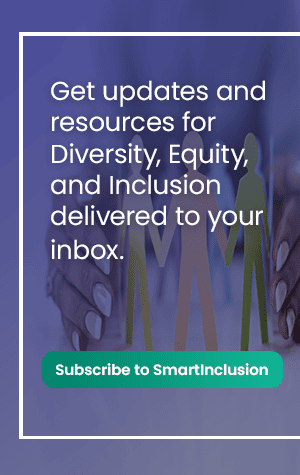In this video conversation on solutions for Diversity, Equity & Inclusion in the workplace, Sylvia Dahlby, DE&I Champion at SmartSearch, talks with Larry Goldberg, Accessible Media and Technology Consultant and Former Head of Accessibility at Yahoo, and Kathy Karneth, Principal Consultant at Black Box Consulting, about how employers can upskill and leverage the talents of people with disabilities through accessible design.
What has changed among leading corporations in terms of supporting employees with disabilities both Pre-COVID, during COVID, and today?
Pre-COVID, everybody worked in an office, so it was easier. When employers needed to do an ADA or ergonomic assessment for an employee with a disability, we could have an individual that supported Ergo-assessments go to someone’s desk, look at the technology, look at the workstation, and determine whatever accommodation was needed. The Ergo-assessor could be with the individual worker, talk to them on-site and find out the challenges and what they need, and then figure out a path forward.
Then COVID hits, and boom, everybody went remote. Initially, we thought this was temporary. So we looked at what to do with individuals who needed accommodations in an office; how do we get that to their home-work space that could be just about anywhere in the house, like dining room tables, even in a closet so that they couldn’t hear the kids. The challenge was, how do we get some of the accommodations to individuals at home?
Eventually, we realized work-from-home was becoming permanent. So we had to pivot and decide again what to do with accommodations. We had to analyze the accommodations process, look for gaps and figure out how to put a robust, sustainable program in place.
We interviewed quite a few employees with disabilities. One of the most interesting things we learned is that new challenges popped up when we sent everybody home.
new challenges popped up when we sent everybody home.
But some opportunities for better communication arose as well. Once all of the major video conferencing platforms added closed captioning as a standard feature, most of the time free, those of us who struggled to comprehend everything being said in a conference room, 1:1 conversation, or noisy cafeteria suddenly had speech-to-text on demand. Sure, sometimes it’s less than 100% accurate, but it sure does help.
What talents/skills are companies seeking to address these issues? Specifically, what gaps do organizations need to address in recruiting people with disabilities?
The attention on diversity, equity, and inclusion initially left out people with disabilities. People didn’t realize that this is a community that needed to be served, workers as well as customers. As companies realized their products needed to be more accessible, they also began to understand that what they purchased for their employees needed to be more accessible. This is basically good, solid design sense and development.
“Good design is accessible design, and accessible design is good design.”
Companies began to get that if we’re designing products and services for just a segment of the marketplace, we’re not doing a good job. If we’re leaving people out, we’re not doing good business. So understanding things like how to make a delightful and intuitive user interface that also works for people with a cognitive disability or hearing disability began to come to the forefront of the development process. There are some straightforward basic coding skills for websites or apps that will make your products much better.
What’s the business case for accessible design for people with disabilities, and why is this important?
Well, there’s the litigation side of things. It’s the last reason you should do it, not the first. There have been lawsuits filed against major tech companies, banks, and every kind of business for lack of accessibility. You don’t want to deal with that if you could readily accomplish accessibility goals before anyone complains.
If you’re the company that shows that you care about accessibility and tackle them as companies like Google, Apple, Microsoft, Salesforce, and Facebook have done, it makes people want to do business with you. Consumers and employees alike feel better about the trust and authenticity.
When it comes to diversity recruiting, employers must include outreach to people with disabilities since they are part of every underserved and under-represented community. How can employers best weave this into their DEI efforts?
The job seeker’s first view of a company is a career site. Make sure that you’re showing the world that you have an accessibility policy. Show that it’s easy for an applicant to request accommodation at every step of the recruitment process and that it will be fulfilled.
About our speakers:
Larry Goldberg has more than 35 years of experience as an innovative leader, entrepreneur, inventor, advisor, and mentor. He has advanced access to a wide range of media and technology for people with disabilities, driving inclusive policies, processes, and organizational infrastructures for employers, large and small, across the full spectrum of non-profits, public institutions, and private sector industries.
Kathy Karneth builds and manages strong cross-functional teams that support merging organizations, diverse cultures, change management strategies, sustainable processes, policies, and organizational structures. She recently led a global initiative to analyze a company’s disability accommodations processes, identify gaps and develop a proposal to create a sustainable program.
Both Larry and Kathy collaborated on bringing disability-friendly initiatives to Yahoo. Kathy researched Yahoo’s human resources capabilities and developed enhanced accommodations processes, while Larry, as Yahoo’s Head of Accessibility, focused on advancing the accessibility of the company’s products.
About the Smart Inclusion conversations:
As we develop our HR technology platform to support diversity in recruiting and employment equity, we’re talking with our clients, vendor partners, industry advocates, and thought leaders on trends, challenges, and solutions to create a more inclusive workplace.